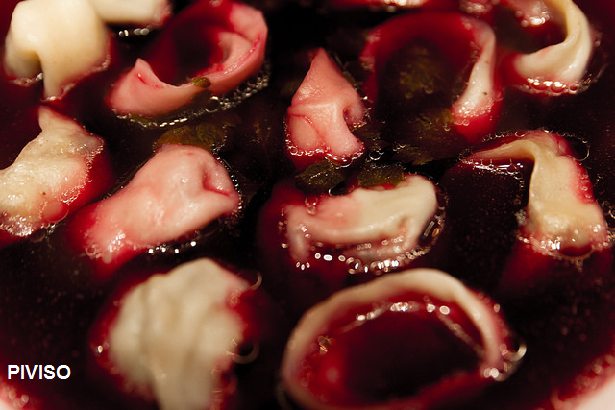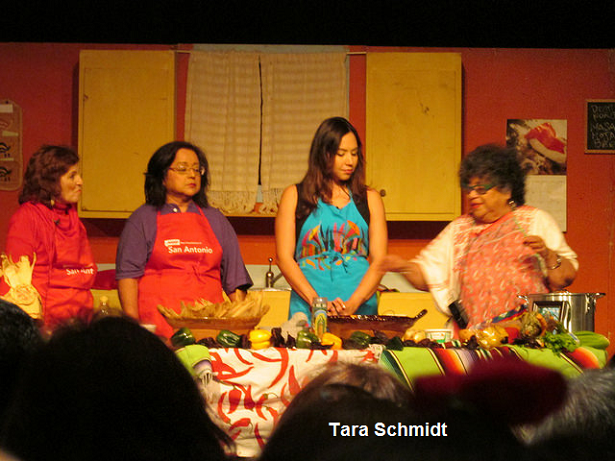QT 69 – Global Christmas Culinary Traditions

Why Hello There, and welcome back to Kitchen Catastrophes Quick Tips, where we crack open the Yule log of various facets of food culture, and root around for tasty grubs and facts. I’m your boorish boar of broad bearing, Jon O’Guin, and today, I’m ACTUALLY GOING TO DO SOMETHING AHEAD OF TIME. Today, a full FIVE DAYS before Christmas, we’re going to talk about Christmas foods. Let’s do this.
I Could Really Go for Some Bear-Claus
Starting off strong with the dumb puns. Alright, so, the first thing we need to discuss is our framing of today’s post. We’re not going to talk about my personal Christmas foods, because I was already emotionally vulnerable and open on Monday, and one bout of internationally-available emotional exposure per week is more than enough in my mind. Speaking of internationally available, since Monday’s post was about an African soup, I think it’ll be fun to take an international eye on this post.
So we’re not going to be discussing the turkeys, hams, cookies, and…jams, I guess, if I want that rhyme to pan out, of your typical US Christmas (A ‘ChristmUS’, perhaps?) but rather we’ll be visiting South America, Africa, Europe, and Asia to deliver you some real ICBMs (Intercontinental Christmas-Based Meals)
It’s always bothered me that we included the C from “intercontinental”. Like, I get we can’t call them IBMs, but we picked the name. We could have given it other letters.
Alright, let’s get our magical Santa hats on and whisk ourselves around the world for some new Noel Noms.
Japan: Crazy for Chicken
I like this example for complicated reasons we’ll address later. But you know what Japanese people LOVE to eat on Christmas? Chicken. And not just Chicken, but Fried Chicken. AND not just Fried Chicken, but KENTUCKY FRIED CHICKEN.
I guess he KIND OF looks like Santa Claus,
That’s right, KFC does gang-busters in Japan during Christmas time. In 2017, almost 1/10th of all the sales of KFC nationally in Japan happened from December 23rd to December 25th. That’s a Friday, Saturday, and Sunday, and it was 10% of the ENTIRE YEAR’S sales. That means they had to sell more chicken in those three days than they did in some of their MONTHS.
How did this happen? Why does Japan love Fried Chicken for Christmas when, fun fact, less than 2% of Japan is even Christian, and therefore CARES about Christmas? To which the answer is “a really good marketing campaign”.
Back in 1970, there was a man named Takeshi Okawara, and he was the manager of the FIRST KFC in Japan. He was also a graduate of Harvard Business School, because Japan’s economy is crazy-town frolics. That December, he started something. He claimed it came to him in a dream, but others note that a school-teacher might have approached him with the initial pitch: we’ll buy KFC for our class’s Christmas lunch, if you come dressed as Santa. Within 4 years, the ad campaign Karisimasu ni wa Kentakkii, which translates as “Kentucky for Christmas” was born. (If you’re wondering why “Christmas” and “Kentucky” look so weird in Japanese, you can refer back to my discussion on phonotactic constraints from last year. Or don’t, I’m not the police.)
44 years later, and “Kentucky for Christmas” is now just an ongoing thing. (Also, Takeshi was eventually promoted to President of KFC Japan, because when a man makes you a billion dollars, you promote his ass. Unless you’re Taco Bell.) Part of that is the success of Suteki na Holiday, which is a popular Japanese Christmas song that is the theme of the campaign since 2000. For mental comparison, imagine if “All I Want For Christmas is You” was the direct theme song of Burger King during the holidays.
Have a Holly Jolly Whopper!
And if you’re motivated to have a little chuckle at the Japanese for buying so readily into an ad campaign, let’s not forget how much we’ve let Coca-Cola get away with setting up our modern picture of Santa Claus (though they were not the first), or how much we all seem to suddenly care about Mexican Independence five days into May, and then stop caring about ANY of that nation’s political history by the Sixth.
But if you think Fried Chicken in the nation of Nigiri is weird, I assure you, we’re going to get stranger still. But first, let’s get some Fish with our pasta, as we hit up Italy.
Italy/Europe: Seven Fishes for Seven Brothers
This one is a little mixed up, and that’s because Italian cuisine is messed up. PUT DOWN THE KNIFE, ARMANDO, Let me explain.
“You get un minutto, O’Guin. Then the knife comes back.”
So, Italy, as I’ve mentioned before (…while talking about Japan. That’s a weird coincidence.), has roughly 19 distinct recognized regional cuisines. As such, it should shock very few of you to learn that those regional cuisines DON’T all cook the same foods for Christmas. BUT, certain things are common, and I’m going to use this section’s dish as a catch-all for a variety of traditions, because it’s actually a catch-all of multiple dishes: The Festa dei Sette Pesca, or, in English, the Feast of Seven Fishes.
Italy, in case you didn’t know, is quite Catholic.
“Catholic Central” , really.
And part of Catholic doctrine is fasting. During Lent and other holidays, good Catholics abstain from eating meat, a rule of such importance that it is why the beaver is officially a fish in Catholicism. (Canadian fur trappers back in the 17-1800’s complained that, during winter, there was little they could eat during such fasting days, and pointed out that Beavers have scaled tails and swim, and the Pope said “then I guess it’s fine.”)
As such, most Italian households avoid meat on Christmas, as do MANY other European countries. Poland, for instance. However, to ensure that no one could miss that this was still a festive time, Italians would go all out, making a feast of 7* different fish dishes.
It sounds like a SAW movie designed specifically for me.
Eels, Anchovies, Mussel, Shrimp, Smelt, Clams, Salt Cod, Calamari and normal Cod and more bedeck the tables of Italian houses come Christmas. The keen-eyed among you will notice that I listed 9 fish for 7* dishes. And they’ve also noticed I’ve used an asterisk on that 7 twice now. The fact is that the ‘feast of SEVEN fishes’ is kind of more of an Italian AMERICAN thing. It still happens in Italy, of course, but they’re a little looser on the rules. Families that are struggling may only have one dish (typically eel, which is a delicacy in Italy), while other families might do seven fish, nine, ten, or as high as thirteen. Each with its own theological explanation. Seven for instance, is considered “God’s number”, because it’s the most repeated number in the Bible and Catholic theology. Seven Days, Seven Sins, Seven Holy Sacraments, etc. Nine represents the Holy Trinity three times, Ten for the stations of the Cross, and 11-13 for the Apostles. (11 if you don’t include Judas, 13 if you include both him AND Jesus)
And THAT tradition, of a wide array of dishes or courses based on Christian doctrine, is ANOTHER expansive tradition in various European countries. Poland, again, for instance, almost always does 12 dishes for Christmas dinner. And since, as I noted earlier, it’s got to be meatless, you can see some real innovations. Though the traditional starter is a special Christmas Borscht.
Tortellini in Borscht look remarkably graphic without context.
So Europe is chowing down on entire schools of Fish for the holidays, but what about some warmer climes? Well, we can show you how they do it down in Puerto Rico.
Central/South America: Nothing Quite Like Christ-mas-a
I lied just then, to force a mental link to Despacito. We’re not going to show you how they do it in Puerto Rico. Puerto Rico is a US territory, and I SAID we weren’t doing American traditions. I apologize that my dumb musical references led you astray.
Lo siento
What we WILL cover are the traditions of places like Costa Rica and Guatemala. Which are (and I understand I’m already on thin ice by using a Bieber song lyric to transition to your proud heritages, so I beg your clemency with this over-simplification, amigos) basically the same, in that they mostly trace to the same food and source: the tamale, and the Aztecs.
Tamales, if you’re unaware, are a food made by encasing a filling in a masa dough, and cooking the dough to a soft shell. It’s (VERY) roughly equivalent to the pierogis of Eastern Europe, the hand pies of Western Europe, and other such inventions: a dish with a long cultural heritage founded mostly on the premise that it was one of the first foods you could carry with you while walking around all day and not worry about it going bad.
They come in their own pouches!
This was further reinforced by the cosmology of the region: Corn was hugely important to Mezo-American peoples, and thus tamales were as well (since masa is a regional type of cornmeal/corn flour). Tamales were so well regarded that they were considered to be a sacrifice on par with things like “the hearts of our enemies” and other flashy things that warriors and the wealthy would offer to the gods in times of festival. Which is really just canny socio-economic thinking in a religion; I mean, if you demand your farmers start bringing jaguar claws to temple, you’re going to end up with a lot fewer farmers and a lot fatter jaguars.
In any case, this religious/festival connection to the tamale was NOT broken by the Spanish arrival and…let’s call it “cultural realignment” that followed. Instead, the farmers simply changed which gods they were offering their tamales to, and eating the tamales at parties for.
AS such, tamaladas or tamale-making-parties, are quite common in Central and South American homes, as well as Mexican-American homes around Thanksgiving, Christmas, and basically any other holiday where it’s not too hot to cram a bunch of people into one kitchen and stand over a boiling pot for a couple hours.
Which is basically a summation of how I spend Christmas, just with less saturated colors.
One last point before we move on: you may note I explained what a tamale was very vaguely earlier. “a Filling encased in masa dough”, and that was by design. While most Americans are familiar with savory tamales like pollo verde or cerdo rojo (“chicken in green sauce” and “pork in red sauce”, respectively), there’s actually no limit to what can be put in them. Beef, Pork, Chicken, Honey, Cinnamon, Apples, as I noted, these are like hand pies, and like hand-pies, they can be adapted much more broadly than most think.
And in the spirit of surprising culinary twists, let’s take this tour to our last destination, Africa.
Africa: Do They Know It’s Christmas?
Real shitty question there, 1980’s America. Of course they know it’s Christmas, they have the same damn calendars. It just means a lot of different things to them.
Africa has a….well, I don’t want to call it a “problem” with Christmas. However, there is something to be noted about it. See, I joked last section that the peoples of Central and South America like to gather and make tamales “whenever it’s not too hot to all cram into one kitchen.” What I didn’t point out in that statement was that, for many of those cultures, CHRISTMAS is going to be the high-water heat mark.
THIS is what Johannesburg looks like in December.
As most Westerns know, and then promptly forget to actually visualize and relate to, due to how the world tilts, the seasons in the Northern Hemisphere are SWAPPED from those in the Southern. The coldest days in Argentina hit in July, not January. And the same is true of the majority of Africa. To most of Africa, the December solstice is equivalent to ours in June.
This means that the culinary traditions are VERY different. African cultures tend to go out and grill or barbecue to celebrate Christmas. Some will, in a very culturally confusing turn of events, traipse out the trappings of their former colonizing nations, since, you know, THEY were the ones who really cared about it. Like, British Beef Wellington isn’t uncommon to find on African tables come December 25.
It’s a truly shocking cultural moment to learn that the traditional Kenyan Christmas dish is…grilled goat. Because it’s basically their version of the 4th of July: everyone’s drinking, hanging out with family, and having a good time in the good weather.
Again, look at all that damn sunshine these guys get in January.
I do want to touch on one thing I’ve HEARD. Supposedly, in South Africa, there’s an unusual Christmas snack: Deep fried Caterpillars. But my research tells me this is wrong.
Kind of.
What IS true is that the Mopane worm, which is the caterpillar to a type of moth, is a frequently harvested protein source for many southern African countries, including Botswana, Zimbabwe, South Africa and Zambia. And that the worms are often served deep-fried.
Here they are, pre-sizzle-dip.
Thus, it’s not fair to call mopane worms a “South African Christmas snack” any more than it would be to call Mashed potatoes a traditional American Christmas dish. Yes, we EAT mashed potatoes at Christmas, but that’s because we eat them at EVERY holiday/family dinner in the cooler months.
And that’s this year’s list. And let me tell you, I did not hit HALF of what I could have. There’s interesting Christmas dishes still scattered around Europe and Asia I didn’t even get to IMPLY. The Philippines traditionally roast a whole PIG! France invented Log-Cakes because they stopped making Fireplaces! And maybe we’ll get to talking about them next year. For now, let’s call it a night. A SILENT NIGHT. I need to sleep.
MONDAY: NO POST, SINCE IT’S CHRISTMAS EVE. HAVE A HAPPY HOLIDAY EVERYONE!
THURSDAY: I SHOULD PROBABLY SKIP THIS ONE TOO, BUT I BELIEVE IN MYSELF TO THROW TOGETHER SOMETHING. MAYBE SOME SORT OF KITCHEN CATASTROPHE HOLIDAY SPECIAL. I DON’T KNOW.
THE REAL QUESTION IS: AM I GOING TO DO SOMETHING FOR NEW YEAR’S EVE?


















